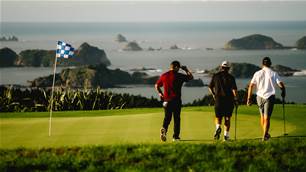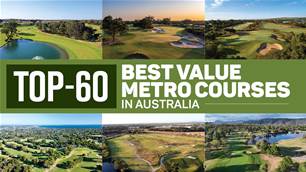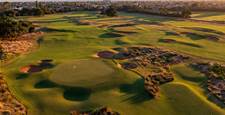Stretching east from the outer suburbs of Melbourne to the New South Wales border, north to the Great Dividing Range and south to the Bass Strait coastline, Gippsland incorporates snowfields, old growth forests, rolling green pastures, beaches and lakes.
About 25 minutes’ drive east of Warragul is Trafalgar Golf Club, which dates back to 1909 and has been on its present site north of the township of the same name since 1953. This original layout was cleared and routed by members and all 18 holes were completed by 1960. Two years later, acclaimed course architect Vern Morcom was commissioned to redesign the layout and 12 holes were changed.
The course has changed little during the past six decades and today it is widely acclaimed as a great test for accomplished players and an enjoyable venue for mid- and high markers as well as casual golfers. The beautifully kept playing surfaces are also highly regarded.
Like most of the courses in Gippsland, Trafalgar is not long with the par-70 measuring just 5,647 metres from the back pegs. However, length is not the main defence of par here with tight driving lines created by the thick avenues of trees lining each fairway. That said, the longest hole on the course is a memorable one. The 531-metre par-5 10th is a genuine three-shotter as it descends from an elevated tee to a fairway that doglegs left twice before reaching the green.
Doglegs are a real feature of the course, with the likes of the double breaking par-5 6th and the sharp dogleg right par-4 8th being highlights of the round.

Heading south back to the highway, the Moe Golf Club is a leisurely 20-minute drive east. Established in 1934, the course has relocated twice but settled on its present site in 1964. Not unlike Trafalgar, the layout was designed by the members in two parts during 1965 and ’66. As a result, Moe has two contrasting nines – the outward half covers gently undulating topography, while the back nine is longer with generously wide fairways and some views of nearby Lake Narracan.
Towering native gums cover the course, which boasts very good greens and well-maintained Legends couch fairways. In fact, the fairways had a reputation for being quite poor until a decision was made back in 2001 to introduce the Legends couch, which was nurtured from sprigs planted on the 18th fairway and spread throughout the course. Today, the quality of the fairways is a real highlight of a round here.
The construction of a new dam in the late 2000s to increase the club’s irrigation capacity brought water into play on three holes, including the testing 182-metre par-3 4th hole, which plays slightly shorter than the scorecard suggests. Two of the nine bunkers on the course protect the front of this smallish green.
Pulling out of the car park, it is just a few minutes’ drive to the neighbouring Yallourn Golf Club. Despite its name, the course is not actually in Yallourn (where it was originally located until the early 1960s) but is spread across rolling terrain at Yallourn North.

The club moved to this site in the early 1950s after the State Electricity Commission advised that the land occupied by the Club was needed for expansion the open cut mine. Negotiations with the commission resulted in the club leasing the present site.
The new course was designed by long standing club member Henry Barr, who was the chief surveyor of the commission in the Latrobe Valley. His main principle in creating the layout related to the fact golf, at that time, was considered a winter game, with afternoon rounds common. He routed the course so no player should ever have to look into the sun after playing a shot.
There is no record Barr had any experience in course design, but he certainly created a terrific layout with some holes that would impress the most experienced course architect. Some of the most memorable holes feature on the outward nine with the 355-metre par-4 2nd and the uphill par-3 3rd holes being favourites of this writer. The view from the elevated tee of the par-4 2nd is superb and during the cooler months you can see all the way to the snow-covered peaks of the Baw Baw ranges to the north.

Traralgon Golf Club, which is no more than 25 minutes’ drive east of Yallourn, was a regular stop on the PGA Tour of Australasia in the late 1970s. A young Greg Norman was a two-time winner around the layout in 1978 and ‘79, shooting 11-under-par for four rounds on both occasions.
The club moved to its present site in the late 1930s and Vern Morcom was commissioned to design the layout. It opened for play in 1940 and much of his work has remained unchanged for the past 83 years. In more recent times, however, all the greens have been converted to bentgrass, while Santa Ana couch grass has been introduced to many fairways with great success.
For mine, the par-3s at Traralgon are a standout attraction with the 165-metre 8th being the best of the lot. The prevailing wind here blows from behind and slightly across right-to-left and really can hamper club selection as you contemplate the shot needed to successfully carry the distance from the elevated tee to the green perched on another hill. In between tee and green is a valley with a picturesque pond and, while it doesn’t come into play for good players, it is a magnet for the golfer easily intimidated by water.

Morcom was prolific in designing quality layouts throughout Gippsland, with the likes of Traralgon, Trafalgar, Leongatha and Lakes Entrance all becoming part of his legacy to the game in Victoria. It is testament to his skill that few major changes have been made to any of these layouts during the past 60 to 70 years.
One of Morcom’s contemporaries, Sam Berriman – perhaps best known for his work at Melbourne’s Huntingdale and Southern Golf Clubs – was also attracted to work in Gippsland in 1950.
It was in that year when Sale Golf Club – having been established 50 years earlier – moved to its current location alongside the Latrobe River and a new layout created by Berriman.
Two highlights come early in the round at the 354-metre 4th and 295-metre 5th – both very good par-4s that hug the edge of the river.

The slight dogleg right 4th features out-of-bounds in the wetlands along its entire length to the right, so the conservative line into the left half of the fairway is preferred. At the next, big hitters will like their chances of reaching the green from the tee, but they must contend with deep fairway bunkers that stretch for nearly 50 metres along the edge of the driving zone.
Major changes have been proposed for the Sale course as the club looks at a development opportunity, which will finance a significant upgrade of their course.
Course design team Neil Crafter and Paul Mogford (Golf Strategies) was commissioned to create a masterplan that will see up to six new holes incorporated into a layout of remodelled existing holes.
It is understood the new holes will cover gently undulating terrain covering a natural sandy base featuring some sand dunes, offering views across the adjoining wetlands where black swans, spoonbills and egrets make their home.
Related Articles

Touring New Zealand: The complete golfing package












